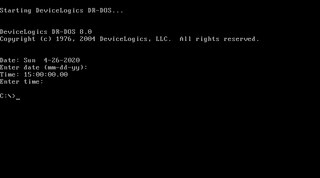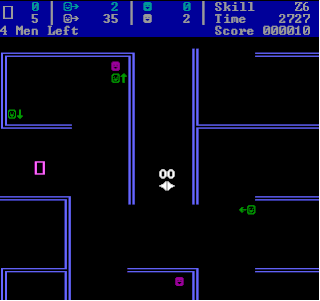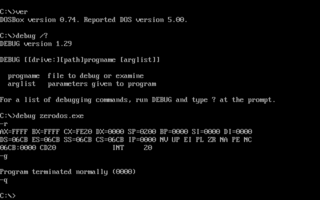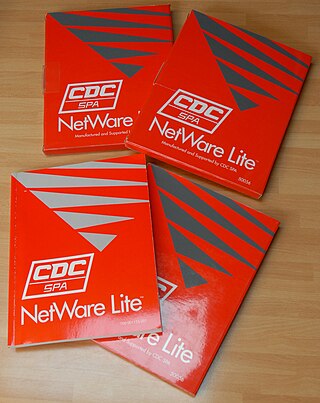
DR-DOS is a disk operating system for IBM PC compatibles, originally developed by Gary A. Kildall's Digital Research, Inc. and derived from Concurrent PC DOS 6.0, which was an advanced successor of CP/M-86. Upon its introduction in 1988, it was the first DOS that attempted to be compatible with IBM PC DOS and MS-DOS.

COMMAND.COM is the default command-line interpreter for MS-DOS, Windows 95, Windows 98 and Windows Me. In the case of DOS, it is the default user interface as well. It has an additional role as the usual first program run after boot. As a shell, COMMAND.COM has two distinct modes of operation: interactive mode and batch mode. Internal commands are commands stored directly inside the COMMAND.COM binary; thus, they are always available, but can only be executed directly from the command interpreter.
In computing, the working directory of a process is a directory of a hierarchical file system, if any, dynamically associated with the process. It is sometimes called the current working directory (CWD), e.g. the BSD getcwd function, or just current directory. When a process refers to a file using a simple file name or relative path (as opposed to a file designated by a full path from a root directory), the reference is interpreted relative to the working directory of the process. So for example a process with working directory /rabbit-shoes that asks to create the file foo.txt will end up creating the file /rabbit-shoes/foo.txt.
VxD is the device driver model used in Microsoft Windows/386 2.x, the 386 enhanced mode of Windows 3.x, Windows 9x, and to some extent also by the Novell DOS 7, OpenDOS 7.01, and DR-DOS 7.02 multitasker (TASKMGR). VxDs have access to the memory of the kernel and all running processes, as well as raw access to the hardware. Starting with Windows 98, Windows Driver Model was the recommended driver model to write drivers for, with the VxD driver model still being supported for backward compatibility, until Windows Me.
An environment variable is a user-definable value that can affect the way running processes will behave on a computer. Environment variables are part of the environment in which a process runs. For example, a running process can query the value of the TEMP environment variable to discover a suitable location to store temporary files, or the HOME or USERPROFILE variable to find the directory structure owned by the user running the process.

DOS/V is a Japanese computing initiative starting in 1990 to allow DOS on IBM PC compatibles with VGA cards to handle double-byte (DBCS) Japanese text via software alone. It was initially developed from PC DOS by IBM for its PS/55 machines, but IBM gave the driver source code to Microsoft, who then licensed a DOS/V-compatible version of MS-DOS to other companies.
ANSI.SYS is a device driver in the DOS family of operating systems that provides extra console functions through ANSI escape sequences. It is partially based upon a subset of the text terminal control standard proposed by the ANSI X3L2 Technical Committee on Codes and Character Sets.

ViewMAX is a CUA-compliant file manager supplied with DR DOS versions 5.0 and 6.0. It is based on a cut-down runtime version of Digital Research's GEM/3 graphical user interface modified to run only a single statically built application, the ViewMAX desktop. Support for some unneeded functions has been removed whilst some new functions were added at the same time. Nevertheless, the systems remained close enough for ViewMAX to recognize GEM desktop accessories automatically and to allow some native GEM applications to be run inside the ViewMAX environment. Many display drivers for GEM 3.xx could be used by ViewMAX as well, enabling ViewMAX to be used with non-standard display adapters and higher resolutions than possible using the default set of ViewMAX drivers. Also, Digital Research's SID86, the symbolic instruction debugger that shipped with DR DOS 3.xx and provided dedicated functions to debug GEM applications, could be used for ViewMAX as well.
Virtual DOS machines (VDM) refer to a technology that allows running 16-bit/32-bit DOS and 16-bit Windows programs when there is already another operating system running and controlling the hardware.

Snipes is a text-mode networked computer game that was created in 1983 by SuperSet Software. Snipes is officially credited as being the original inspiration for NetWars. It was one of the earliest text mode multi player games, running on Novell NetWare systems.
"Zero-copy" describes computer operations in which the CPU does not perform the task of copying data from one memory area to another or in which unnecessary data copies are avoided. This is frequently used to save CPU cycles and memory bandwidth in many time consuming tasks, such as when transmitting a file at high speed over a network, etc., thus improving the performance of programs (processes) executed by a computer.
Long filename (LFN) support is Microsoft's backward-compatible extension of the 8.3 filename naming scheme used in MS-DOS. Long filenames can be more descriptive, including longer filename extensions such as .jpeg, .tiff, and .html that are common on other operating systems, rather than specialized shortened names such as .jpg, .tif, or .htm. The standard has been common with File Allocation Table (FAT) filesystems since its first implementation in Windows NT 3.5 of 1994.
A disk compression software utility increases the amount of information that can be stored on a hard disk drive of given size. Unlike a file compression utility, which compresses only specified files—and which requires the user to designate the files to be compressed—an on-the-fly disk compression utility works automatically through resident software without the user needing to be aware of its existence. On-the-fly disk compression is therefore also known as transparent, real-time or online disk compression.
A NetWare Loadable Module (NLM) is a loadable kernel module that can be loaded into Novell's NetWare operating system. NLMs can implement hardware drivers, server functions, applications, system libraries or utilities.

The line-oriented debugger DEBUG.EXE is an external command in operating systems such as DOS, OS/2 and Windows.
Computer hardware or software is said to be bug compatible if it exactly replicates an undesirable feature of a previous version. The phrase is found in the Jargon File.

NetWare Lite and Personal NetWare are a series of discontinued peer-to-peer local area networks developed by Novell for DOS- and Windows-based personal computers aimed at personal users and small businesses in the 1990s.

MSCDEX or Microsoft CD-ROM Extensions is a software program produced by Microsoft and included with MS-DOS 6.x and certain versions of Windows to provide CD-ROM support. Earlier versions of MSCDEX since 1986 were installable add-ons for MS-DOS 3.1 and higher.
In computing, LOADHIGH is an internal DOS command in COMMAND.COM that is used to load a program into the upper memory area (UMA) instead of conventional memory.
DOS Protected Mode Services (DPMS) is a set of extended DOS memory management services to allow DPMS-enabled DOS drivers to load and execute in extended memory and protected mode.








